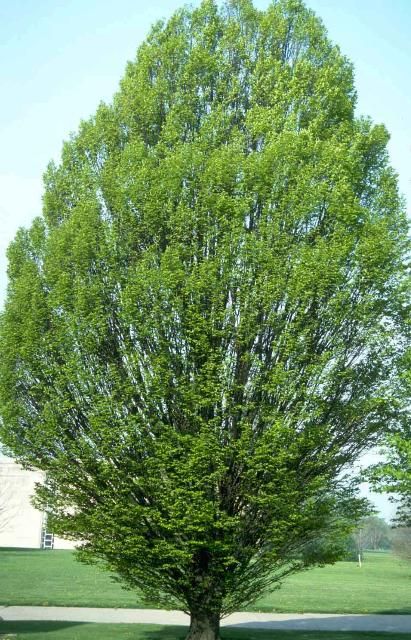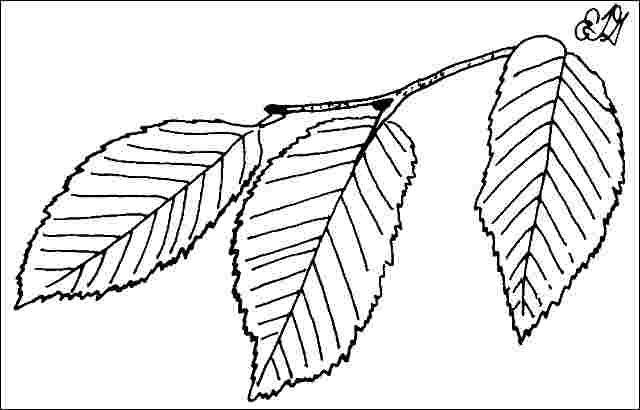Introduction
'Fastigiata' European hornbeam, the most common cultivar sold, grows 30 to 40 feet tall and 20 to 30 feet wide, without a central leader but instead fans out into a very densely foliated, columnar or oval-shaped tree, making it ideal for use as a hedge, screen, or windbreak. The 1.5- to 3.5-inch-long leaves are dark green through the summer, fading to yellow in the fall. The smooth, grey, rippling bark shields the extremely hard, strong wood. This wood is so solid it was reportedly used by the ancient Romans to make chariots, as well as being used by the American pioneers to make yokes for their oxen.

Credit: Ed Gilman
General Information
Scientific name: Carpinus betulus
Pronunciation: kar-PYE-nus BET-yoo-lus
Common name(s): 'Fastigiata' European Hornbeam
Family: Betulaceae
USDA hardiness zones: 5A through 8B (Fig. 2)
Origin: not native to North America
Invasive potential: little invasive potential
Uses: parking lot island < 100 sq. ft.; parking lot island 100–200 sq. ft.; parking lot island > 200 sq. ft.; container or planter; highway median; urban tolerant; specimen; espalier; hedge; screen; street without sidewalk; sidewalk cutout (tree pit); tree lawn 3–4 feet wide; tree lawn 4–6 feet wide; tree lawn > 6 ft. wide; Bonsai
Availability: not native to North America

Description
Height: 30 to 40 feet
Spread: 15 to 20 feet
Crown uniformity: symmetrical
Crown shape: upright/erect, columnar, pyramidal
Crown density: dense
Growth rate: slow
Texture: fine
Foliage
Leaf arrangement: alternate (Fig. 3)
Leaf type: simple
Leaf margin: double serrate
Leaf shape: ovate, oblong
Leaf venation: pinnate
Leaf type and persistence: deciduous
Leaf blade length: 2 to 4 inches
Leaf color: green
Fall color: yellow
Fall characteristic: showy

Flower
Flower color: white/cream/gray
Flower characteristics: not showy
Fruit
Fruit shape: oval
Fruit length: less than .5 inch
Fruit covering: dry or hard
Fruit color: brown
Fruit characteristics: attracts birds; not showy; fruit/leaves not a litter problem
Trunk and Branches
Trunk/bark/branches: branches don't droop; not showy; typically one trunk; thorns
Pruning requirement: little required
Breakage: resistant
Current year twig color: brown
Current year twig thickness: thin
Wood specific gravity: unknown
Culture
Light requirement: full sun, partial sun or partial shade
Soil tolerances: sand; loam; clay; acidic; alkaline; well-drained; occasionally wet
Drought tolerance: high
Aerosol salt tolerance: none
Other
Roots: not a problem
Winter interest: yes
Outstanding tree: yes
Ozone sensitivity: unknown
Verticillium wilt susceptibility: resistant
Pest resistance: resistant to pests/diseases
Use and Management
The tree is sold as tree-form for street tree use or low-branching for use as specimens and screens. Young trees will be quite narrow but they will broaden some with age, making them well adapted for planting in areas with limited horizontal space for crown development. It has been rated very highly in the Shade Tree Evaluation tests for street trees in Ohio. The upright branching habit makes pruning almost unnecessary during the service life of the tree, but of course, the tree will not form a canopy over the street as do broad-spreading trees. European hornbeam tolerates clipping extremely well and has been used as a screening plant for centuries.
'Fastigiata' European hornbeam will grow in full sun or light shade on almost any well-drained soil, from dry and rocky to wet. It adapts to both acid and alkaline soil and is tolerant of drought, poor drainage, pollution, and urban conditions. There are specimens in the South that look great, having received no irrigation in recent droughts. These plants were observed growing in clay soil where soil space was not limiting, and roots were able to expand unhindered by urban structures like curbs, pavement and sidewalks. Due to the dense arrangement of leaves on the fine-textured, upright stems, pruning is seldom required once the proper branch-height clearance is established early in the life of the tree. Usually pest-free, it is considered a low maintenance tree.
Propagation is by grafting.
Pests and Diseases
Occasionally bothered by two-lined chestnut borer or trunk canker. Japanese beetle can eat significant quantities of foliage in parts of the upper South. May die back in severe drought in areas with limited soil space such as narrow tree lawns or parking lot islands. But it performs well without irrigation in areas with open soil where roots can grow unrestricted.